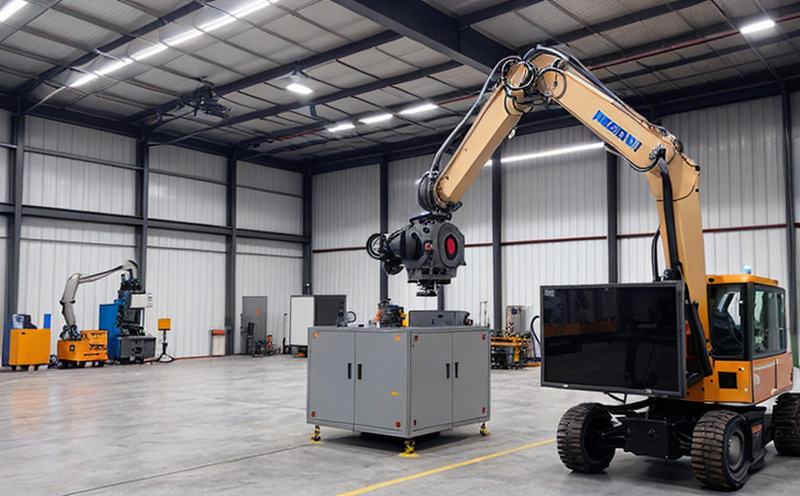UL 2900-1 Cybersecurity Evaluation of Industrial Robot Systems
The UL standard UL 2900-1 is an internationally recognized benchmark for the cybersecurity evaluation of industrial robot systems. This standard ensures that robotic devices are designed, manufactured, and installed in a manner that protects against unauthorized access, data breaches, and other cyber threats. Compliance with this standard is essential for manufacturers and users of industrial robots to meet regulatory requirements and enhance system security.
The UL 2900-1 evaluation process involves several critical steps aimed at identifying potential vulnerabilities and implementing protective measures. The first step is a thorough risk assessment, which evaluates the potential threats and impacts on the robotic systems. This is followed by a detailed analysis of the cybersecurity architecture to identify any gaps or weaknesses that could be exploited.
A significant part of the evaluation involves conducting a variety of tests designed to simulate real-world attack scenarios. These tests are critical in understanding how industrial robots respond under adversarial conditions. The UL 2900-1 standard mandates rigorous testing protocols, including but not limited to:
- Network security assessments
- Data protection and encryption evaluations
- Vulnerability scanning for known exploits
- Penetration testing to identify weaknesses in the system's defenses
The results of these tests are meticulously documented, providing a comprehensive report that outlines any identified vulnerabilities along with recommendations for corrective actions. This transparency ensures that manufacturers and users can make informed decisions regarding cybersecurity measures.
Compliance with UL 2900-1 is not just about meeting regulatory requirements; it also enhances the reputation of industrial robot systems by demonstrating a commitment to security best practices. In an era where cyber threats are increasing, adherence to this standard provides peace of mind and helps build trust among stakeholders.
The impact of such evaluations extends beyond compliance—it can significantly influence product development cycles, improve operational efficiency, and reduce the risk of costly downtime or data breaches. By incorporating UL 2900-1 into their processes, manufacturers are better equipped to protect their systems and mitigate potential risks.
Benefits
The implementation of UL 2900-1 brings numerous benefits, both for the manufacturer and end-user. One of the primary advantages is the enhanced security posture that it affords. By ensuring that industrial robots meet stringent cybersecurity standards, manufacturers can protect their systems from unauthorized access and data breaches.
From a compliance standpoint, adherence to this standard ensures that products meet regulatory requirements, thereby reducing the risk of non-compliance penalties or market disruptions. This also opens up opportunities for international markets where UL certification is recognized.
In terms of operational efficiency, ensuring robust cybersecurity can lead to fewer system downtimes due to security breaches. This translates into reduced maintenance costs and improved productivity. Additionally, meeting this standard can enhance the reputation of manufacturers, making them more attractive to potential clients and partners.
For end-users, UL 2900-1 provides peace of mind knowing that they are using a system that has been rigorously tested for security. This can be particularly important in sectors where data privacy is critical, such as healthcare or finance.
The standard also facilitates the integration of industrial robots into larger cybersecurity frameworks. By ensuring that individual components meet high standards, it becomes easier to create cohesive and secure systems across different industries and applications.
International Acceptance and Recognition
UL 2900-1 is an internationally recognized standard for the evaluation of industrial robot cybersecurity. Its acceptance extends beyond national borders, making it a valuable tool for manufacturers looking to penetrate global markets. Many countries have adopted this standard as part of their regulatory frameworks, recognizing its importance in protecting critical infrastructure.
International standards like UL 2900-1 play a crucial role in harmonizing requirements across different jurisdictions. This consistency ensures that products meet the necessary security criteria regardless of location or industry. Recognized by key international bodies such as ISO and IEC, this standard is widely accepted in Europe (EN) and North America.
The widespread adoption of UL 2900-1 underscores its significance in the global manufacturing landscape. By adhering to this standard, manufacturers can ensure that their products meet international standards, thereby reducing barriers to entry into foreign markets. This recognition also enhances credibility and trust among stakeholders, contributing to long-term business success.
For users of industrial robots, compliance with UL 2900-1 provides assurance that the systems they deploy are secure against cyber threats. This is particularly important in critical infrastructure sectors where security breaches could have severe consequences. The standard's international recognition ensures that these systems meet global best practices, enhancing overall safety and reliability.
Use Cases and Application Examples
- Automated Assembly Lines: In manufacturing environments, industrial robots are often used in automated assembly lines. UL 2900-1 ensures that these systems are secure against potential cyber threats, protecting sensitive data and ensuring continuous operation.
- Warehouse Management Systems: Robots employed in warehouse management can handle a variety of tasks, from sorting packages to inventory control. Compliance with this standard helps ensure the security of these operations, preventing unauthorized access or disruptions.
- Smart Factories: In smart factory settings, industrial robots are integrated into larger networks that manage production processes. UL 2900-1 ensures that these systems can operate securely within a broader cybersecurity framework.
- Healthcare Robotics: Robots used in healthcare environments require stringent security measures to protect patient data and ensure the safe operation of critical medical devices.
- Retail Robotics: In retail settings, robots are used for tasks such as inventory management and customer service. Compliance with UL 2900-1 ensures that these systems operate securely and efficiently.
The application examples above illustrate the broad range of industries where industrial robot systems are deployed. By ensuring compliance with UL 2900-1, manufacturers can provide robust cybersecurity solutions that meet the diverse needs of various sectors.





